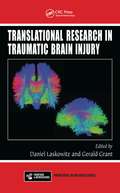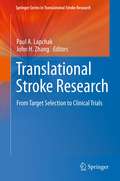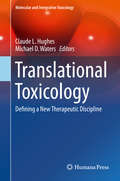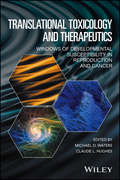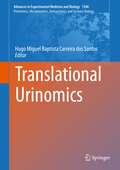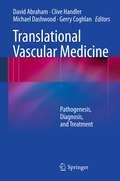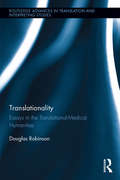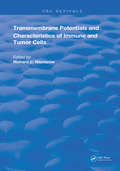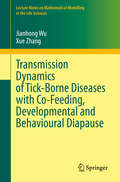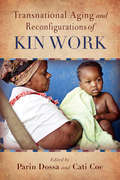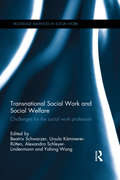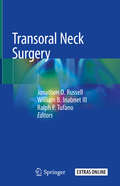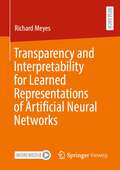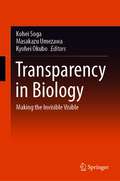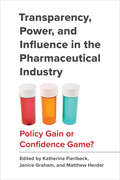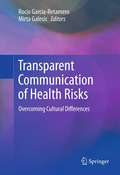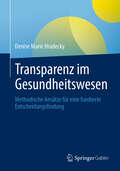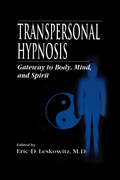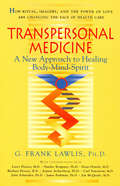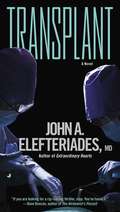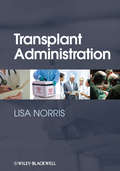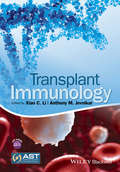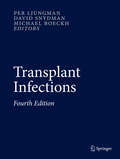- Table View
- List View
Translational Research in Traumatic Brain Injury (Frontiers In Neuroscience Ser.)
by Daniel Laskowitz Gerald GrantTraumatic brain injury (TBI) remains a significant source of death and permanent disability, contributing to nearly one-third of all injury related deaths in the United States and exacting a profound personal and economic toll. Despite the increased resources that have recently been brought to bear to improve our understanding of TBI, the developme
Translational Stroke Research
by Paul A. Lapchak John H. ZhangThis volume sets a basis for effective translational research. Authored by experts in the field of translational stroke research, each chapter specifically addresses one or more components of preclinical stroke research. The emphasis is placed on target identification and drug development using state-of-the-art in vitro and in vivo assays, in combination with in vitro toxicology assays, AMDE and clinical design.
Translational Toxicology
by Claude L. Hughes Michael D. WatersBringing together adistinguished interdisciplinary team of contributors, this volumeprovides a comprehensive exploration of translational toxicology--a systematicapproach to developing therapeutic interventions that can protect against,mitigate, or reverse the effects of exposures. In particular, the bookaddresses modes of action and biomarkers, developmental risks of exposures, andpotential translational toxicology therapeutics. The result is a compellingapplication of developmental toxicology in a new therapeutic discipline that isdestined to become part of standard medical practice. TranslationalToxicology: Defining a New Therapeutic Discipline is an essential text for regulatory authorities, scientists, andphysicians who are concerned with environmental exposures, public health, nutrition,and pharmaceutical research and development. Basic science, epidemiological,and clinical investigators will also find this book a significant resource.
Translational Toxicology and Therapeutics: Windows of Developmental Susceptibility in Reproduction and Cancer
by Claude L. Hughes Michael D. WatersWritten by leading research scientists, this book integrates current knowledge of toxicology and human health through coverage of environmental toxicants, genetic / epigenetic mechanisms, and carcinogenicity. Provides information on lifestyle choices that can reduce cancer risk Offers a systematic approach to identify mutagenic, developmental and reproductive toxicants Helps readers develop new animal models and tests to assess toxic impacts of mutation and cancer on human health Explains specific cellular and molecular targets of known toxicants operating through genetic and epigenetic mechanisms
Translational Urinomics (Advances in Experimental Medicine and Biology #1306)
by Hugo Miguel Baptista Carreira dos SantosTranslational Urinomics provides an overview of urine analysis using proteomics, metabolomics, transcriptomics or any combination thereof for the diagnosis and prognosis of diseases related to the urinary system and the kidneys. The text approaches urine biomarkers from a new perspective, incorporating up-to-date studies of mass-spectrometry-based biomarker discovery as well as the latest advances in personalized medicine. The integration of technology-driven techniques, such as OMICS also provides a unique opportunity for improved diagnostics accuracy of urinary-related diseases. For nephrologists and urologists looking for new approaches to well-known problems, this edited volume serves as a valuable guide.
Translational Vascular Medicine
by Michael Dashwood Gerry Coghlan Clive Handler David AbrahamTranslational medicine underpins vascular medicine. It is fundamental to understanding how we treat patients with vascular disease and more importantly, how to prevent it. It is the rationale for drug design and production. Vascular medicine and translational medicine will take over and become the main reason for referring patients to hospital. Therefore, hospital-based clinicians working with basic scientists need to know about translational medicine, which educates and informs them about vascular medicine and how management should be based. This book is a primer for translational vascular medicine and discusses the evolving and exciting areas of basic science applied to vascular medicine. The book is based on the third vascular biology conference held at The Royal College of Physicians in 2008. It provides a large amount of new basic and clinical information and the contributors are world leaders.
Translationality: Essays in the Translational-Medical Humanities (Routledge Advances in Translation and Interpreting Studies)
by Douglas RobinsonThis book defines "translationality" by weaving a number of sub- and interdisciplinary interests through the medical humanities: medicine in literature, the translational history of medical literature, a medical (neuroscience) approach to literary translation and translational hermeneutics, and a humanities (phenomenological/performative) approach to translational medicine. It consists of three long essays: the first on the traditional medicine-in-literature side of the medical humanities, with a close look at a recent novel built around the Capgras delusion and other neurological misidentification disorders; the second beginning with the traditional history-of-medicine side of the medical humanities, but segueing into literary history, translation history, and translation theory; the third on the social neuroscience of translational hermeneutics. The conclusion links the discussion up with a humanistic (performative/phenomenological) take on translational medicine.
Transmembrane Potentials & Characters Immune & Tumor Cell (Routledge Revivals)
by Richard C. NiemtzowFirst Published in 1979, this book offers a full, comprehensive guide into the potential application of immune and tumor cells. Carefully compiled and filled with a vast repertoire of notes, diagrams, and references this book serves as a useful reference for students of oncology, and other practitioners in their respective fields.
Transmission Dynamics of Tick-Borne Diseases with Co-Feeding, Developmental and Behavioural Diapause (Lecture Notes on Mathematical Modelling in the Life Sciences)
by Jianhong Wu Xue ZhangThis monograph introduces some current developments in the modelling of the spread of tick-borne diseases. Effective modelling requires the integration of multiple frameworks. Here, particular attention is given to the previously neglected issues of tick developmental and behavioral diapause, tick-borne pathogen co-feeding transmission, and their interactions. An introduction to the required basics of structured population formulations and delay differential equations is given, and topics for future study are suggested. The described techniques will also be useful in the study of other vector-borne diseases. The ultimate aim of this project is to develop a general qualitative framework leading to tick-borne disease risk predictive tools and a decision support system. The target audience is mathematical biologists interested in modelling tick population dynamics and tick-borne disease transmission, and developing computational tools for disease prevention and control.
Transnational Aging and Reconfigurations of Kin Work
by Parin Dossa Cati Coe Delores V. Mullings Erin L. Raffety Karen Kobayashi Kristin Elizabeth Yarris Loretta Baldassar Mushira Mohsin Khan Neda Deneva Yanqiu Rachel ZhouTransnational Aging and Reconfigurations of Kin Work documents the social and material contributions of older persons to their families in settings shaped by migration, their everyday lives in domestic and community spaces, and in the context of intergenerational relationships and diasporas. Much of this work is oriented toward supporting, connecting, and maintaining kin members and kin relationships—the work that enables a family to reproduce and regenerate itself across generations and across the globe.
Transnational Social Work and Social Welfare: Challenges for the Social Work Profession (Routledge Advances in Social Work)
by Beatrix Schwarzer Ursula Kämmerer-Rütten Alexandra Schleyer-Lindenmann Yafang WangThe underlying frame of social work is the nation state, and it is from within the state that welfare strategies and social policies are devised and implemented. However, post-colonialism, globalisation, migration and the associated implications for human rights, social justice and social welfare policies contest the idea of a clearly defined space for social work and present new challenges for researchers and practitioners. Transnational Social Work and Social Welfare argues for the increased importance of the transnational perspective in social work theory and practice. The book challenges the idea of the nation state as a given entity and argues that globalization and an increasing number of people crossing borders must have an impact on the theories and strategies of social work. The international contributors are critical of a restricted focus on a geographically defined space and the impact on work with clients. With cases covering China, France, India, UK, Germany, Malaysia, Israel, Turkey, the book highlights the challenges as well as the opportunities this new perspective can open up for theories and strategies in social work. It will be of interest to students, researchers and social workers interested in migration, social care, poverty and cultural competency in health and social care.
Transnational Social Work and Social Welfare: Challenges for the Social Work Profession (Routledge Advances in Social Work)
by Beatrix Schwarzer Ursula Kämmerer-Rütten Alexandra Schleyer-Lindenmann Yafang WangThe underlying frame of social work is the nation state, and it is from within the state that welfare strategies and social policies are devised and implemented. However, post-colonialism, globalisation, migration and the associated implications for human rights, social justice and social welfare policies contest the idea of a clearly defined space for social work and present new challenges for researchers and practitioners. Transnational Social Work and Social Welfare argues for the increased importance of the transnational perspective in social work theory and practice. The book challenges the idea of the nation state as a given entity and argues that globalization and an increasing number of people crossing borders must have an impact on the theories and strategies of social work. The international contributors are critical of a restricted focus on a geographically defined space and the impact on work with clients. With cases covering China, France, India, UK, Germany, Malaysia, Israel, Turkey, the book highlights the challenges as well as the opportunities this new perspective can open up for theories and strategies in social work. It will be of interest to students, researchers and social workers interested in migration, social care, poverty and cultural competency in health and social care.
Transoral Neck Surgery
by William B. Inabnet III Ralph P. Tufano Jonathon O. RussellThis text will serve as a guide for both the head and neck surgeon and the general surgeon in the technical and clinical aspects of transformative transoral neck surgery. It provides the reader with a comprehensive understanding of transoral approaches, including surgical indications, techniques, and outcomes. Such indications include thyroid disease, parathyroid disease, neck dissection, and other head and neck pathology. Instrumentation, setup, and the role of additional technologies such as nerve monitoring and robotics are reviewed in depth, followed by additional chapters on techniques, pearls, pitfalls, controversies, and challenging cases. The volume concludes with the current state of robotics in transoral surgery, and takes a look at future directions. Written and edited by experts in the field, Transoral Neck Surgery will be a valuable guide for the thousands of clinicians implementing this surgery.
Transparency and Interpretability for Learned Representations of Artificial Neural Networks
by Richard MeyesArtificial intelligence (AI) is a concept, whose meaning and perception has changed considerably over the last decades. Starting off with individual and purely theoretical research efforts in the 1950s, AI has grown into a fully developed research field of modern times and may arguably emerge as one of the most important technological advancements of mankind. Despite these rapid technological advancements, some key questions revolving around the matter of transparency, interpretability and explainability of an AI’s decision-making remain unanswered. Thus, a young research field coined with the general term Explainable AI (XAI) has emerged from increasingly strict requirements for AI to be used in safety critical or ethically sensitive domains. An important research branch of XAI is to develop methods that help to facilitate a deeper understanding for the learned knowledge of artificial neural systems. In this book, a series of scientific studies are presented that shed light on how to adopt an empirical neuroscience inspired approach to investigate a neural network’s learned representation in the same spirit as neuroscientific studies of the brain.
Transparency in Biology: Making the Invisible Visible
by Kohei Soga Masakazu Umezawa Kyohei OkuboThis book explains transparency in biology with emphasis on bending and absorption, which together are the essence of transparency. The reader is provided with an understanding of why the interior of the body can be made to appear transparent through the application of elementary physics. Based on the principle of transparency, emerging imaging techniques using near-infrared light to view the body transparently are explained with examples such as cancer detection and temperature imaging of deep tissues. This book is useful to many researchers, including biologists, physicists, chemists, materials scientists, and device engineers as well as developers—all who seek a deep understanding of transparency in bioimaging.
Transparency, Power, and Influence in the Pharmaceutical Industry: Policy Gain or Confidence Game?
by Katherine Fierlbeck, Janice Graham, Matthew HerderThere is plenty of controversy surrounding pharmaceuticals, but it cannot be denied that the pharmaceutical industry is both socially beneficial and profitable. Regulators are expected to ensure that the economic success of the industry does not come at the expense of public safety, yet they have also assumed a cooperative role by providing advice on regulation and by targeting unmet medical needs. Concerns over regulatory standards, conflicts of interest, and the manipulation of information on drug safety and effectiveness have led to public mistrust and a greater need for transparency between the pharmaceutical industry and government regulators. Transparency, Power, and Influence in the Pharmaceutical Industry evaluates the progress made in holding the pharmaceutical industry responsible for creating transparency in the industry, from development to market. The contributors to this volume examine the various mechanisms introduced to make the regulatory process more informative and situate these efforts within the larger project of enhancing the safety of drugs, vaccines, and other products.
Transparent Communication of Health Risks
by Rocio Garcia-Retamero Mirta GalesicRecent research in health decision making has shown that many patients, even those with a college education, have difficulties grasping a host of numerical concepts, including percentages and probabilities. Yet, basic numeracy and graph literacy are essential for understanding information relevant to making decisions about health, such as the incidence and prevalence of different diseases, risk reductions from medical screenings and treatments, and risk increases from side effects of treatments and unhealthy behaviors. Patients who have problems understanding such numerical concepts are often prone to errors in risk perception and medical choices. Importantly, informed medical decision making, heavily reinforced these days by the legal requirement for informed consent, depends critically on communication of quantitative medical information. Meeting the challenge of effectively communicating medical information to patients with different levels of numeracy and graph literacy has become more important than ever. Transparent Communication of Health Risks describes a series of cross-cultural studies investigating how people in countries with different medical and educational systems understand numerical and graphical information, what they know about existing medical treatments and screenings, which presentation formats help them better understand the relevant information, and how they use the data to make medical decisions. Focusing on the careful measurement of necessary knowledge and skills, the book also includes validated numeracy and graph literacy scales in English, Spanish, and German. Some of the topics covered in the book are: numeracy and graph literacy for health;measuring risk comprehension in educated samples;communicating information about medical treatment and screening;reducing the effect of framed messages about health;the effect of individual differences on shared decision making; andtransparent health information in the media.Transparent Communication of Health Risks emphasizes the importance and value of working toward the development of tailored risk communication interventions and clarifies the tasks ahead for health psychologists, public health professionals, pharmaceutical and medical education companies, medical physicists, and nurses.
Transparenz im Gesundheitswesen: Methodische Ansätze für eine fundierte Entscheidungsfindung
by Denise M. HradeckyIn einer Zeit, in der das Gesundheitssystem vor enormen Herausforderungen steht – von finanziellen Engpässen über Fachkräftemangel bis hin zu steigenden Patientenerwartungen – wird Transparenz zu einem entscheidenden Faktor für Qualität, Effizienz und Patientenorientierung. Dieses Buch bietet eine umfassende und praxisorientierte Anleitung zur Förderung von Transparenz im Gesundheitswesen. Nach einer fundierten Einführung in die Bedeutung und Zielsetzung von Transparenz werden Definitionen, historische Entwicklungen und aktuelle Relevanz beleuchtet, insbesondere im Kontext des deutschen Gesundheitswesens. Die Einführung des Transparenzgesetzes und die damit verbundenen Herausforderungen werden detailliert analysiert. Internationale Best-Practice-Beispiele bieten wertvolle Einblicke und Vergleichsmöglichkeiten. Erfolgsfaktoren und Hindernisse bei der Implementierung von Transparenzstrategien werden untersucht, um praxisnahe Lösungen zu entwickeln. Moderne Technologien wie elektronische Patientenakten, künstliche Intelligenz und Big Data spielen dabei ebenso eine Rolle wie die ethischen und rechtlichen Rahmenbedingungen. Ein besonderer Schwerpunkt liegt auf der Entwicklung und Umsetzung eines strukturierten Transparenz-Leitfadens. Dieses Buch richtet sich an politische Entscheidungsträger, Gesundheitsdienstleister und Wissenschaftler, die sich für die Förderung von Transparenz und Qualität im Gesundheitswesen einsetzen möchten. Es bietet nicht nur Orientierung, sondern auch konkrete Handlungsempfehlungen, um den komplexen Herausforderungen im Gesundheitswesen mit fundierten Entscheidungen und innovativen Strategien zu begegnen.
Transpersonal Hypnosis
by Eric D. LeskowitzTranspersonal Hypnosis presents a multidimensional, energy-based view of human awareness that integrates disparate biological, psychological, and spiritual therapeutic techniques. Each of the chapters - all from world-renowned contributors - includes both a historical overview and the theory behind the development of each technique. The authors emphasize experimental studies that examine the validity of using hypnotically accessed transpersonal states of consciousness to heal the body, mind, and spirit. Several clinical vignettes highlight the types of medical and psychological symptoms responsive to these approaches. The emerging field of spiritually-influenced treatments is transforming the practice of medicine.
Transpersonal Medicine: The New Approach To Healing Body-mind-spirit
by G. Frank LawlisTranspersonal Medicine chronicles the pioneering efforts to apply a transpersonal orientation to the field of medicine. Broken into three parts, it reviews the underlying principles of transpersonal medicine. Part one focuses on ritual as a means of cross-personal empowerment. Part two is devoted to the personal ritual, the process of empowering one's inner strengths and wisdoms. Part three is dedicated to direct experiences and issues involved in medicine. The book includes interviews with leading researchers in each field of topics.
Transpersonal Perspectives on Spirituality in Social Work
by Edward R Canda Elizabeth D SmithUse these ideas in your social work practice to help the whole person--including your client's spiritual side!Transpersonal Perspectives on Spirituality in Social Work brings to light the fact that spiritual well-being is an essential part of the health of every individual. It will show you how to facilitate and encourage growth in the transpersonal dimension for your clients and help you to address the full range of human potential--from material and psychological well-being to spiritual fulfillment.Beginning with conceptual and theoretical frameworks for understanding transpersonal theory, Transpersonal Perspectives on Spirituality in Social Work goes on to deliver empirical and clinical studies that center on true-life experiences and their social work practice implications. In this well-researched book you will find: a comparative analysis of various models of spirituality and spiritual development a study of chronically ill adults that shows how people can draw upon transpersonal experiences and beliefs to increase their resiliency suggestions for alleviating death-related anxiety with a transpersonal/social constructionist approach theoretical, empirical, and practical insights into transpersonally oriented hospice work a model for transpersonal couples work that promotes compatibility and intimacy ways to differentiate between delusions, hallucinations, and real spiritual breakthroughs an examination of the different styles of spirituality of African Americans and European Americans and how they relate to the expression of violenceIn this well-referenced volume, practical techniques and suggestions combine with ways to work for justice and empowerment for marginalized and oppressed populations as well as insights about the fundamental connectedness between people and nature. Helpful diagrams, charts, and tables make the information user-friendly. Transpersonal Perspectives on Spirituality in Social Work will help you expand the horizons of your practice and provide more effective services to your clients.
Transplant
by John A. ElefteriadesWhat do you do when you have to choose between saving a life or saving yourself? Renowned cardiac surgeon Dr. Athan Carras's first concern has always been the welfare of his patients. Then he's approached by the very wealthy and even more powerful Terry Flynnt--a man who is used to getting what he wants, no matter what. Flynnt's son is dying, and his only chance of survival is to receive a donor heart--one that Terry intends to obtain by whatever means necessary. Athan is immediately opposed to performing an illegal and immoral operation, but Flynnt is not about to let that stop him. Now, caught in the crosshairs of a man with unlimited means and influence, Athan finds his own life--and the lives of those he loves--being torn apart. And he will have to decide how far he's willing to go, and what he is willing to sacrifice...
Transplant Administration
by Lisa NorrisThis timely new book, written by a transplant administrator with over sixteen years of experience, along with other expert contributors, covers the specifics of each aspect of transplant administration, providing information that will enable new administrators to quickly master essentials, help more seasoned administrators evaluate and improve their programs, and generally provide a knowledge base, focused on best-practices in light of regulatory requirements, for transplant surgeons, aspirant administrators and hospital administrators.Comprehensively covers all aspects of transplant program administration, including management, finance, staffing, quality improvement, patient intake, communication and collaboration with clinical staff, and more.Emphasizes practical application of best practices; uses bullet lists and other features to highlight essential information for each topic covered.Accompanying "Toolkit", available via the book's companion website, provides forms, a procedural manual, program assessment materials and more which buyers can use "out of the box" or adapt for use in their own program.While the book and its supplemental materials have been created specifically with the US transplant community in mind, they still have considerable value for transplant administrators and related professionals outside the US, for instance, transplantation and health policy researchers, hospital management staff who are tasked with starting a transplant program from scratch and who need ready-made materials they can adapt to suit their own regulatory environment, and others.
Transplant Immunology
by Anthony M. Jevnikar Xian C. LiWith all the complex issues of acceptance or rejection of a transplanted organ, immunology is a key subject for all transplantation clinicians. During recent years, there has been an explosion of research and knowledge in this area. Produced in association with the American Society of Transplantation, and written by experts within the field, Transplant Immunology provides a comprehensive overview of the topic in relation to clinical transplantation. Starting with the basic functionality of the immune system, it then moves on to cover the very latest developments in immunosupressive drugs and protocols, as well as a look at all emerging technologies in the field. Key chapters include: Transplant-related complications Immune responses to transplants Emerging issues in transplantation Biomarkers of Allograft rejection and tolerance T cells and the principles of immune responses In full colour throughout, over 100 outstanding diagrams support the text, all figures being fully downloadable via the book′s companion website. The result is an essential tool for all those responsible for managing patients awaiting and undergoing organ transplantation, including transplant surgeons and clinicians, immunologists and researchers.
Transplant Infections: Fourth Edition
by Per Ljungman David Snydman Michael BoeckhAs the number of patients undergoing hematotopoietic or solid organ transplantation increases, a deep understanding of the field of transplant infectious diseases grows increasingly vital. With its extensively revised and updated review of surgical infections, treatment, prevention, and practice, this book is the ultimate guide to advances in the field of transplant infections that are rapidly implemented into practice both in diagnostic technologies, new therapies, new transplant practices, and challenges such as the threat of multiresistant bacteria and the increasing use of transplantation in the developing parts of the world. Written by experts in their fields, this book is the only comprehensive source of cutting-edge information on transplant infections and has been a trusted guide to medical professionals worldwide for nearly two decades.Transplant Infections is of paramount value to infectious disease specialists, transplant physicians, medical students, fellows, residents, and all medical professionals working with surgical patients.
